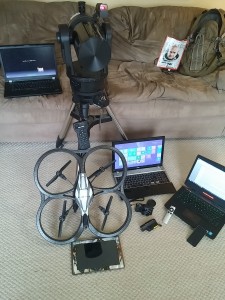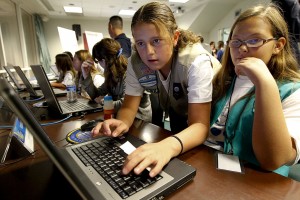I understand many people in the world don’t really know what Computer Science is. First let me explain clearly what it is not: It is not Microsoft Word, PowerPoint, Excel, or Google Apps. It is not photo editing. It is not making a movie. It is certainly not keyboarding. Those are all wonderful tools to learn and YES they are practical and helpful , but-—NO–they are not Computer Science.

Learning to type is NOT Computer Science
So, what then is Computer Science? Probably not what you think. And certainly not what it was 25 years ago, 15 years ago, or even 10 years ago. It has a dynamic property of being redefined, and in some cases reinvented continuously. The world of technology changes so rapidly, the science(and art) that has been developing around that continues to develop as well. But, we do know that there are ways to bring together creativity, puzzles, imagination, software and hardware, algorithms, and hard work to help solve problems. Some of those problems are simple and local, and some are world wide and life changing. That’s Computer Science.
So, how does that look when it’s implemented in schools?
Be careful, this is probably not how class looked like when you were in school and it very well may not be how most schools look today. And it does not involve multiple choice tests and the questions at the end of chapter. My classroom has no “front”, so it is not possible to lecture to the class while they wait for knowledge to come to them. All chairs and tables have wheels so they can move into any configuration needed. Whiteboards are on every wall, so students and teachers can discuss ideas together where-ever they are.
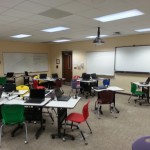
All desks and chairs move. White boards on all walls. No center or front in the room.
Student do not have to raise their hand to talk and they are encouraged to get up out of their seat anytime they like. Class is loud, not quiet–and that’s all on purpose. You see…knowledge and understanding is not
mine to give to them. My role is simply to connect them to it. They’ll have to earn it, work for it, figure it out, and apply it to their own efforts. Enough of my ideas…let’s take a look at what’s happening every day:
In high school, all athletes must take an online concussion test; Trey developed another concussion test. While standing in front of the Kinect camera, the athlete is led through 3 sequential tests of balance that are analyzed by his program as you do them. The results are recorded for future comparison.
Carter developed a digital cheerleader routine tutorial. Standing in front of the Kinect camera, the athlete is led through the experience of an actual complex cheer sequence. As the camera “detects” the person has correctly completed each step, there is confirmation on the screen.
Elen developed a virtual chemistry lab that leads students through a series of activities, practices, procedure directions, including putting on your lab coat. The student does this all while standing in front of the Kinect camera.
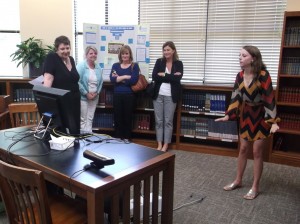
Students demonstrate their final projects to judges and parents
Courtney developed a virtual crime scene analysis program for her AP Biology class. Standing in front of the Kinect camera, students collect potential DNA evidence, go to the lab and actually extract the DNA, and finally compare it to other samples to discover the culprit.
Katherine developed a cartwheel tumbling analysis. While in front of the Kinect camera, you actually perform a real cartwheel, 3 snapshots are taken: one before, one during, and one after the cartwheel to allow you to analyze your motion and position.
McLean developed an interactively practice for learning the English language. As you stand in front of the Kinect camera, random words fall from above you, your challenge is to determine the part of speech of each falling word, actually “grab” it with your hand and “drop” it into the appropriate bucket.
David developed a program that allows the human body, standing in front of the Kinect camera, to generate angles and geometric shapes.
Benjamin developed an interactive language learning experience. Standing in front of Kinect camera, the human body can be used to highlight & unhighlight words, move phrases around, and interact with words on the “air” around you.
Ryan developed a geologic time discovery activity. Standing in front of the Kinect, students must grab various animals and place them in the correct geologic period.
Merritt developed an interactive SAT vocabulary practicing activity. Standing on a dance pad, students control all the activity using their feet. Be ready for the high energy intense speed bonus round.
Richard developed a history learning activity that combined his love of track practice and history. As you literally run and jump hurdles in front of the Kinect camera, you have the chance to respond to questions…all before you make a mad dash for the finish line.
Wyatt programmed his tablet to take GPS satellite readings in order to command a robot to move towards it’s destination.
Travis and Jacob created a voice controlled currency converter app for their mobile phone.
Elizabeth took her part time cashier job experience and put it on the screen to allow younger kids to learn how to calculate correct payment amount when buying things. Using the game controller, the customer pays the exact amount of bills and coins by dragging them onto the coin tray.
These programs took anywhere from a month to 3 months to develop. And they all involved some pretty serious Computer Science to figure out how to implement. But they also required artistic design, storytelling, marketing and sales, math, logical algorithms, some advanced physics, and face to face presentations. They all involved collaboration with other students. Students were evaluated by their day to day work, by their completed program, by their weekly BLOG posts, by their peers, and also by an “unknown” panel of judges. I did not administer any pop quizzes or tests…and yet not once did I ever have any issues with students working hard, learning very challenging topics and skills, pushing the envelope, or losing interest. We had many speakers in class including a copyright lawyer, an executive manager at an international game website, the CEO and entire game design team of a major game design firm, staff from a marketing department, a visit by the head of school to discuss mission statements, and even employees in the Xbox division of Microsoft.
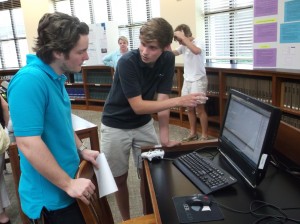
Presentations to others are one of the ways students are evaluated.
The final presentations were done for 2 hours in the library by demonstrating their completed project to a panel of judges ranging from a professional game designer to Computer Science teachers to hard core game players to Computer Science college students to fellow high schoolers to a head of school to a national board certified teacher. You see my point: students had to consider their audience as each judge came to see their project. How you present to a Computer Science teacher is very different to how you present to a college student and even more so different than how you present to corporate marketing manager and yet different again to how you present to a person who designs games for a living. I am 100% certain that this type of experience is more valuable than any paper exam I could give.
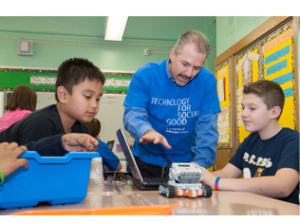
Learning Computer Science early on is crucial to our future as leaders in the world
I am firm believer that Computer Science should be a core subject area from the time students can read and write and express themselves. Those who command the technology of the time will be the leaders of business, entertainment, philanthropy, research, and academia. We cannot wait until students have already developed their learning styles and passions to introduce Computer Science. It must be incorporated into that learning throughout their entire educational path. This is crucial and fundamental to the United States maintaining its place as one of the world’s leading producers of thinkers, great minds, and game changers.
There is a different way to approach education. If something I said in this post makes sense to you, please browse my other posts…you will most likely find that we have a tremendous amount in common–in which case we should connect.






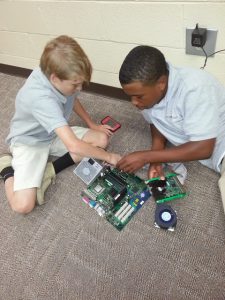
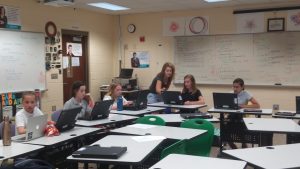
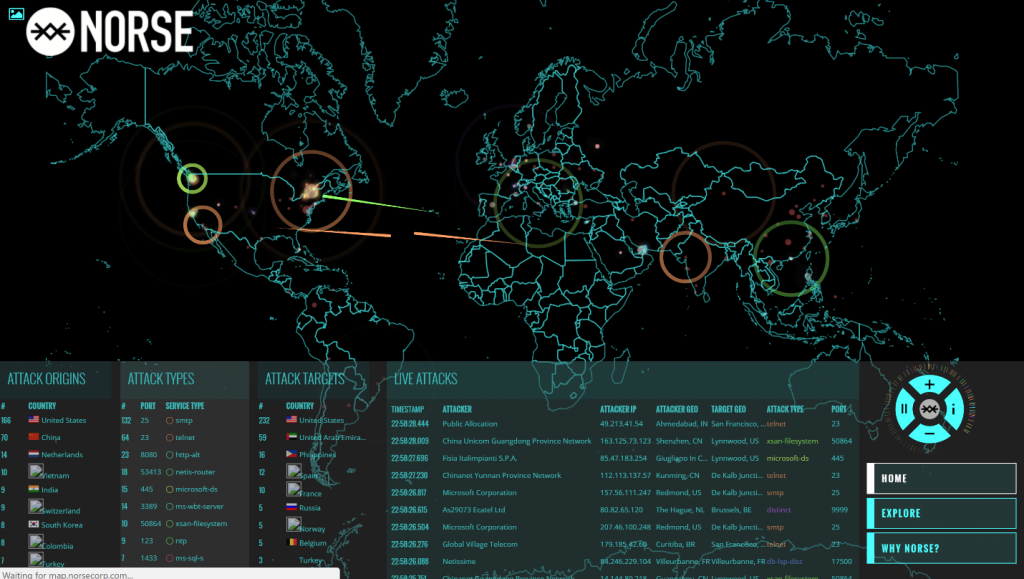 If that doesn’t get your attention, spend 1 minute watching hack-attacks happens live around the world here:
If that doesn’t get your attention, spend 1 minute watching hack-attacks happens live around the world here: 





